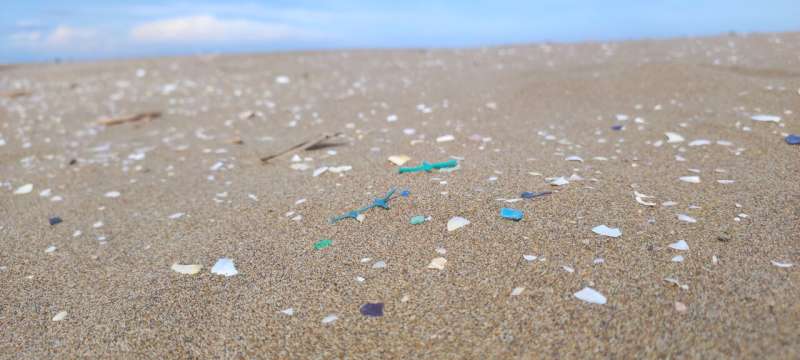This article has been reviewed according to Science X's editorial process and policies. Editors have highlighted the following attributes while ensuring the content's credibility:
fact-checked
trusted source
proofread
All aquatic species in river mouths are contaminated by microplastics, says new report

All aquatic species in the river mouths flowing into the Mediterranean Sea and Atlantic Ocean are contaminated with microplastics, with mollusks being the most affected due to their ability to filter water. Rivers are one of the main sources of pollution by microplastics (5 to 0.0001 mm in size) and nanoplastics (smaller than 0.0001mm) in the oceans.
Estuaries, as transition zones between rivers and the sea, are major hotspots for the accumulation of these particles, which are retained in sediments. They pose a threat to aquatic ecosystems given their ability to capture harmful chemicals from the surrounding environment, enter the food-web through ingestion, and bioaccumulate towards higher trophic levels, including valuable commercial species.
These are the main conclusions of the international project "i-plastic" in which the Institute of Environmental Science and Technology of the Universitat Autònoma de Barcelona (ICTA-UAB) participates, and which has analyzed the presence of micro and nanoplastics in estuaries and their adjacent coasts.
The findings of the project show that of the bivalve species analyzed, 85% of mussels and 53% of oysters had ingested microplastics. Estuarine-dependent marine fishes (white mullet, silver mojarra and Brazilian mojarra) were 75% affected, while in coastal regions influenced by the estuarine outflow, 86% of European hake and 85% of Norwegian lobster contained microplastics or synthetic microfibers in their gut.
Scientists explain that nanoplastic pollution may be even more serious than microplastics and may poses a greater risk to aquatic organisms, as they can pass through the cellular membrane and harm species living in estuarine and marine environments to a greater extent, as was detected in the case of mussels.

"Pollution is ubiquitous in estuaries and their adjacent coasts, in the Mediterranean, and in tropical and temperate zones," says Patrizia Ziveri, oceanographer at ICTA-UAB and coordinator of the project, who points out that the amount of accumulated particles in sediments has increased in recent decades at the same rate as global plastic production, and that since 2000, the particles deposited on the seafloor have tripled.
This pollution poses a global threat to coral reef systems at all depths, causing a reduction in coral reef growth.
Pollution is particularly high near urban centers and wastewater treatment plant outflows, from where microfibers, the most common type of microlitter, are discharged into the estuaries. Once trapped in the seafloor, the particles do not degrade due to lack of erosion, oxygen and light.
"Plastics from the 1960s still remain on the seabed, leaving the signature of human pollution," says Michael Grelaud, oceanographer at ICTA-UAB and coordinator of this project, in which universities in Italy, Portugal, Brazil and Spain have participated.
Particles that are not deposited on the seabed can be transported by ocean currents and tides hundreds of kilometers in just a few months. "A microplastic from the Ebro estuary in the Northwestern Mediterranean Sea can reach Sicily, in Italy, in six months," says Ziveri.
The researchers stress that bioremediation—the use of living organisms to remove pollutants from water—is one of the few viable options available for reducing microplastic pollution in coastal marine environments. Laboratory experiments showed that different species of filter-feeder communities removed almost 90% of the microplastics from surrounding waters.
More information: 10 Facts on microplastics and nanoplastics in estuarine environments
Provided by Autonomous University of Barcelona





















